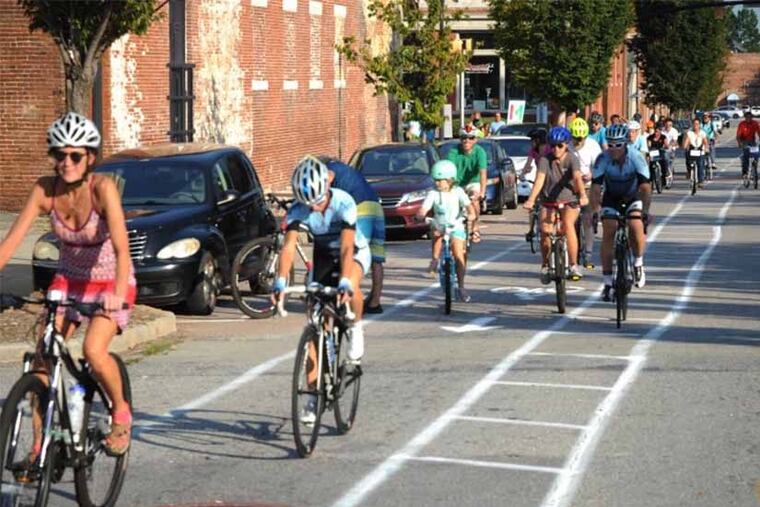Temporary bike grids: How Macon, Ga., won the bike lane culture war | Ideas We Should Steal
Duplicating those results would be a little… utopian for a city like Philly. But a temporary bike grid would likely make cycling safer in areas outside of Center City.

Ideas We Should Steal is a regular feature of the Philadelphia Citizen, which will be holding an Ideas We Should Steal Festival in late 2018.
Philadelphia may have a substantial number of bike riders, but it's far from a cyclist's paradise: Bike lanes are few and far between in several neighborhoods, and things are getting pretty dicey for bikers. Three were killed in traffic in Philly in 2017, and following a recent fatal accident in Spring Garden, Philadelphians are now more attuned to the perils bicyclists face in this city.
Part of the solution to Philly's bike safety woes may lie in the small city of Macon, Ga., which installed temporary bike lanes in 2016.
Josh Rogers is the director of Newtown Macon, a nonprofit focused on making civic and municipal improvements to the Georgia city. He says the concept of installing bike lanes had become a political football over time and a victim of the culture war. The Macon government saw bike lanes as trivial, and often used them as an example of frivolous spending. Macon's leaders especially balked at the estimated cost of a proposed network of interconnected bike lanes, known as a "bike grid" — $25 million.
So, Rogers' team came up with its own plan. Instead of a massive, permanent infrastructure project, the group built a temporary bike grid in Macon's downtown area, stretching along five miles of high-traffic thoroughfares. Using a $500,000 grant won from the Knight Foundation, Newtown Macon finished the grid in late 2016. It was replete with new bike lanes, protective barriers, and bike counters.
>> READ MORE: Spring Garden biker's death epitomizes the clash between Old Philly and New Philly
After Macon residents became acclimated to the bike grid, Rogers says, the culture changed.
"It was no longer a political issue. It was no longer a class issue. It was no longer an infrastructure issue," he says. "It was, like, we have all this asphalt, and we're not using it. Why not let people bike around?"
Cycling also suddenly became way more popular: On streets with bike lanes, the number of bikes was 854 percent higher than on those without them. On one stretch in particular, this figure shot up by 1,758 — yes, 1,758 — percent. The experiment, by any metric, was a massive success. Since an earlier article about this was written last summer, Macon has installed some permanent bike lanes and, according to Newtown Macon, every road that is repaved in the city will be surveyed for bike-lane viability.
Now, duplicating those results would be a little utopian for a city like Philly. But a temporary bike grid would likely make cycling safer in areas outside of Center City. Randy LoBasso, communications manager at the Bicycle Coalition of Greater Philadelphia, says there are entire neighborhoods that don't have a single bike lane.
Northeast Philly, for example, is virtually free of bike lanes, as is the Northwest. South Philadelphia may be home to many cyclists, but the sole bike lanes are on Oregon, Snyder, and Pennrose Avenues, which only cross east-to-west and have no connecting lanes. (Though the city did recently turn 13th and 15th Streets into bikeways.) Hell, Washington Avenue is one of this city's main (and most dangerous) roadways, and its bike lanes are only partial and in disrepair.
>> READ MORE: Top 10 tips for first-time bicycle commuters in Philadelphia
"I think what you have in Philadelphia is sort of an equity problem. If you look at a map of Philadelphia bike lanes, there are a lot of bike lanes near the University of Pennsylvania. There are bike lanes going toward southwest Philadelphia, and on Spruce and Pine, one of the richest neighborhoods in the city," LoBasso says. "But you don't have a lot in North Philly, the Strawberry Mansion area, Kensington."
According to LoBasso, a temporary grid would give neighborhoods a chance to sample bike lanes, get acclimated to them, and then decide for themselves whether they should be permanent. He believes this tryout would show many residents that bike lanes can be implemented without affecting drivers' commutes, and that biking can be a safe, affordable transportation alternative for everyone.
"A temporary bike grid would really open up people's perspective on who is using bikes, and how much easier it is for people and their neighbors to use bikes in those neighborhoods," says LoBasso.
Now, Macon is about one-sixteenth the size of Philly, and such a project would take no small amount of political capital to get moving here. The biggest potential impediment to such an effort? City Council, which needs to sign off on every single proposed bike lane.
Lawmakers gave themselves this veto power in 2012, when the battle between loud-and-proud cyclists — many of whom were transplants to the city — and drivers was at a fever pitch.
Here's an idea: Council could give up its veto power, but only for this temporary grid. Fat chance, though. A mildly inexplicable bill, introduced in February and still in committee, would require a Council ordinance to even modify existing bike lanes.
Let's be real: ceding the power to micromanage bike lanes isn't exactly suspending the writ of habeas corpus. The future is coming on two wheels, baby, and it's time for Council to get hip.
Quinn O'Callaghan is a journalist and staff writer for the Philadelphia Citizen, where a version of this piece originally appeared. His books are represented by Dystel, Goderich & Bourret.